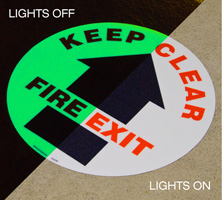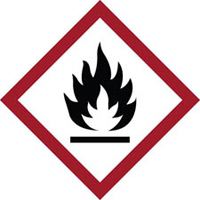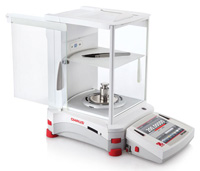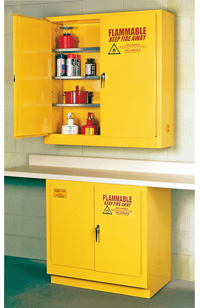



Find all of your laboratory and workplace safety supplies at Safety Emporium!
 Flammable Solid |
 Glossary Index |
 Freezing point |
| MSDS Topics |
Free Sites | FAQ's | Regulations | Glossary | Software | Suppliers |
| Books | Forum | Poll | Fun stuff | Quiz | Store | |
| Understand your MSDS with the MS-Demystifier | Search ALL our MSDS info | |||||

Fire safety includes fire signs, tags and labels from Safety Emporium.
Flash point is the lowest temperature at which a liquid can gives off vapor to form an ignitable mixture in air near the surface of the liquid. The lower the flash point, the easier it is to ignite the material.
For example, gasoline has a flash point of approximately -40 degrees C (-40 °F) and is more flammable than ethylene glycol (antifreeze) which has a flash point of 111 °C (232 °F) in closed cup tests (see below).
A closely related and less common term is fire point, the temperature at which the flame becomes self-sustained so as to continue burning the liquid (at the flash point, the flame does not need to be sustained). The fire point is usually a few degrees above the flash point.
Flash points are required information on Safety Data Sheets under the 2012 edition of 29 CFR 1910.1200, the OSHA Hazard Communication Standard (HCS 2012).
Paragraph B.6 of HCS 2012 requires hazard classification of flammable liquids into one of four Categories using flash points as the criteria:
| Category | Criteria |
| 1 | Flash point < 23°C (73.4°F) and initial boiling point ≤ 35°C (95°F) |
| 2 | Flash point < 23°C (73.4°F) and initial boiling point > 35°C (95°F) |
| 3 | Flash point ≥ 23°C (73.4°F) and ≤ 60°C (140°F) |
| 4 | Flash point > 60°C (140°F) and ≤ 93°C (199.4°F) |

Flame pictograms and other GHS-compliant labels and signs are available from Safety Emporium.
HCS 2012 additionally requires that "The flash point shall be determined in accordance with ASTM D56-05, ASTM D3278, ASTM D3828, ASTM D93-08 (incorporated by reference; See §1910.6), or any other method specified in GHS Revision 3, Chapter 2.6.
The labeling provisions of HCS 2012 require that Category 1, 2, or 3, flammable liquid containers carry the flame pictogram (shown on the right) to provide a quick visual warning of the flammability hazard. The GHS does not require these symbols to appear on the SDS itself, however most responsible manufacturers will do so to preserve the correspondence between a substance's SDS and label.
OSHA's Flammable Liquids Standard 29 CFR 1910.106 mandates flash point determinations using one of above methods (or equivalent) or one of two other standardized testing methods specified by the American Society for Testing and Materials (ASTM). See the next section for full details.
The U.S. Department of Transportation (DOT) requires that all substances transported have a flash point determined and that any materials with flash points lower than 60 degrees C (140 F) be handled with extra caution.
Other agencies and sections of the U.S. Code may specify alternative methods, but the general concept is similar in each case.
Flash points are determined experimentally by heating the liquid in a container and then introducing a small flame just above the liquid surface. The temperature at which there is a flash/ignition is recorded as the flash point.
Two general methods are called closed-cup and open-cup. The closed-cup method prevents vapors from escaping and therefore usually results in a flash point that is a few degrees lower than in an open cup. Because the two methods give different results, one must always list the testing method when listing the flash point. Example: 110 °C (closed cup).
OSHA's 29 CFR 1910.106 standard discusses the methods in some detail:

Laboratory operations are a breeze with Ohaus analytical balances from Safety Emporium.
(a)(14) "Flash point" means the minimum temperature at which a liquid gives off vapor within a test vessel in sufficient concentration to form an ignitable mixture with air near the surface of the liquid, and shall be determined as follows:
(a)(14)(i) For a liquid which has a viscosity of less than 45 SUS at 100 deg. F. (37.8 deg. C.), does not contain suspended solids, and does not have a tendency to form a surface film while under test, the procedure specified in the Standard Method of Test for Flash point by Tag Closed Tester (ASTM D-56-70), which is incorporated by reference as specified in Sec. 1910.6, shall be used.
(a)(14)(ii) For a liquid which has a viscosity of 45 SUS or more at 100 deg. F. (37.8 deg. C.), or contains suspended solids, or has a tendency to form a surface film while under test, the Standard Method of Test for Flash point by Pensky-Martens Closed Tester (ASTM D-93-10) shall be used, except that the methods specified in Note 1 to section 1.1 of ASTM D-93-10 may be used for the respective materials specified in the Note. The preceding ASTM standards are incorporated by reference as specified in Sec. 1910.6.
(a)(14)(iii) For a liquid that is a mixture of compounds that have different volatilities and flash points, its flash point shall be determined by using the procedure specified in paragraph (a)(14) (i) or (ii) of this section on the liquid in the form it is shipped.
(a)(14)(iv) Organic peroxides, which undergo auto accelerating thermal decomposition, are excluded from any of the flash point determination methods specified in this subparagraph.
Flash points must be determined under a set of reproducible circumstances. Automated testing equipment is available from a number of commercial suppliers. If you do not want or need to buy your own equipment, simply consult your local phone directory under "Laboratory, Testing" or a similar heading to find a company that can run a flash point determination for you.
As discussed above, the flash point of the material is one of the required elements on a Safety Data Sheet. Assuming you have a GHS-compliant sheet, the flash point(s) will be listed in Section 9 (physical and chemical properties).
Know the flash point of any material that you work with. Always avoid heat, open flame, sparks or other sources of ignition when a material is near, at or above its flash point. A common laboratory error is failure to pay attention to flash points when using a heating bath. See this document on heating bath materials for more info.
If you see a flame pictogram on the label of your material, this indicates the material is flammable and you should consult your SDS to educate yourself about the hazards and risks of working with the material.

Store your aerosol cans safely with flammable storage safety cabinets from Safety Emporium.
See also: combustible, flammable, NFPA.